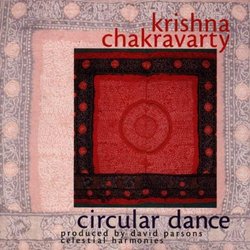| All Artists: Krishna Chakravarty Title: Circular Dance Members Wishing: 0 Total Copies: 0 Label: Celestial Harmonies Original Release Date: 7/17/1998 Re-Release Date: 8/18/1998 Genres: International Music, Pop Styles: Reggae, India & Pakistan, India Number of Discs: 1 SwapaCD Credits: 1 UPC: 013711313321 |
Search - Krishna Chakravarty :: Circular Dance
 | Krishna Chakravarty Circular Dance Genres: International Music, Pop
Circular Dance, produced by New Zealander David Parsons, is the long awaited follow up to Krishna Chakravarty's debut Ananda. It is an exquisite sound document of traditional Indian classical music, and combined with th... more » |
Larger Image |
CD Details
Synopsis
Album Description
Circular Dance, produced by New Zealander David Parsons, is the long awaited follow up to Krishna Chakravarty's debut Ananda. It is an exquisite sound document of traditional Indian classical music, and combined with the accompanied annotation, offers a layman's introduction to the Indian notation system.When speaking of Indian music, one automatically thinks of the raga and the most widely known sitar string instrument. But do we really, as a music loving listening audience, understand or even comprehend what a raga is, or how complex the seemingly simple Indian music system is?The raga, for instance, is essentially a scale with a fixed ascending and descending order of notes. Within this framework are contained specific approaches to certain notes and musical expressions or phrases that differentiate one raga from another. It may seem like free form music, but it is not. It is subject to very strict disciplines which should not be deviated from. And most impressive about this ancient music form is a raga is not something that is composed, but rather something that is discovered.Did you know that Indian classical music is never written down? It isn't, and therefore can never be played from a musical score. In fact, there has never been any notation system developed that could record all of the subtle nuances which characterize this system of music. Today, as in centuries long past, the music is taught orally, and preferably one-to-one. There is, however, the need to at least write something down in order to remember various musical exercises and for those interested in music theory. From this we learn the fundamental note is always called Sa. There is no standard pitch reference in the Indian system so Sa can be any note. In other words, it is simply the musician's individual fundamental pitch that he or she will always use.Dr. Chakravarty features three different raga covering a whole range of rhythms and tempos which correspond to the easily understood annotation, which, seems as if it was written to the inquisitive heart of all music lovers.

 Track Listings (3) - Disc #1
Track Listings (3) - Disc #1